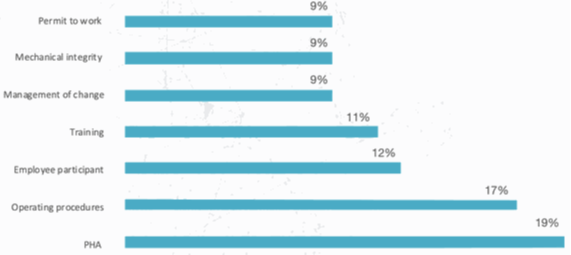How are you developing your new strategy to reduce the PSM related incidents?
PSM Elements Failure Analysis
PSM Elements Failure Analysis
Process safety management (PSM) covers the aspect of process hazard identification, understanding the level of risk and hazard reduction to prevent process-related failures. The need for understanding on how the process safety elements fail is essential in improving the quality of the accidents prevention effort.
The trend of accident rate shows a fluctuation trend while manufacturing sector is still recording the highest trend each year. To understand better, majority of the element failure is classified as design and technical reasons and the rest is related to management related causes.

PSM Accident Causes
To understand the failure reasons in a better way we divided it into main two categories as below
Technical & Design Causes
Management Causes
Research indicated that 47% of accident has happened due to management causes and 53% are due to technical / design causes. Both are concerns but alarming sign is management causes are equally contributing towards major accidents.
Ranking PSM Accident Causes
If we rank the accident causes which contributed in the major accident happened in processing units the outcome can be seen as -


Reducing accident due to management causes requires a proven approach.
In our research finding we identified 4 principle that organization should work on, to reduce PSM related accident.
Reducing accident will require -
Strong Process Safety Culture
Reducing accident will require -
Strong Process Safety Culture
”If you think safety is expensive, try to have an accident. Accident cost a lot of money in terms of damage to the plant, claim for injuries, and the loss of company reputation”.
Missing of strong process safety culture creates a room for error since there is no specific guiding rules. Each one of them will have their own way and style to perform the operation hence resulting in higher tendency of something to go wrong.
Some people are also prone to take a shortcut without thinking of the consequences of their action. This action will contribute to failure and creating hazard to operation and peoples’ life and as well as the environment.
Reducing accident will require -
Reducing risk approach
Reducing accident will require -
Reducing risk approach
Swiss cheese model of defences talk about active and latent failures. Active failures include errors, omissions, and violations. Active failures have a direct and immediate effect on the process.
Latent failures include poor design, gaps in supervision, unworkable procedures, and lack of training. These latent failures are always there, may exist for years and can increase the likelihood of active failures.
Process safety management systems are in place to manage the risk associated with the processes we operate. To manage the risk, it has to be identified, reduced or eliminated. Incidents have to be responded to and the consequences of such incidents have to be rectified.
Knowing that latent failures exist in all processes and systems, identifying these latent conditions is a key element of identifying risk.
Reducing accident will require -
Effective Management
Reducing accident will require -
Effective Management
There are four characteristics of an effective management system. These are:
formality,
flexibility,
accountability and
control
A formalised management system uses procedures, policies, and guidelines to direct personnel to the correct actions and the best resources to manage the process.
A flexible system has mechanisms in place to react to conditions if they change. It is not possible to foresee the future, but it is possible to know what to do in a formalised way when a situation requires action.
In order for a system to work, people must be held accountable to perform the tasks that are required. A system with accountability ensures that there is no question about who is to do what. Add these characteristics together, and the system becomes controlled.
Reducing accident will require -
Data Driven Decision Making
Reducing accident will require -
Data Driven Decision Making
Data-driven decision making (or DDDM) is the process of making organisational decisions based on actual data rather than intuition or observation alone.
Decision-making process which involves collecting data, extracting patterns and facts from that data, and utilising those facts to make inferences that influence decision- making.
Look for enterprise risk management tool that enables the structural and systematic approach towards minimising organisation risk. Real-time insight into risk management can help you make data-driven safety decisions to develop risk reduction strategies.
| Views | |
|---|---|
| 874 | Total Views |
| 1 | Members Views |
| 873 | Public Views |
| Actions | |
|---|---|
| 0 | Likes |
| 0 | Dislikes |
| 0 | Comments |
Share by mail
Please login to share this webpage by email.